Short-Term Climate Oscillations During the Messinian Salinity Crisis: New Insights from Gypsum Lithofacies of the Crati Basin (Lattarico, Calabria, Southern Italy)
Abstract
1. Introduction
2. Geological Setting
- (a)
- The upper Miocene Basal Succession (BaS) outcrops discontinuously along the western side of the CB, unconformably overlying the crystalline Paleozoic rocks. From the base upwards, the BaS comprises conglomerates, sands, and arenites grading into clays and silty clays. The top of this interval consists of an evaporitic succession of Messinian age (i.e., limestone and gypsum) [54];
- (b)
- The Pliocene succession (PS) crops out extensively along the western side of the basin. This interval shows continental conglomerates that grade into marine silty clays [54];
- (c)
- The Pliocene–Pleistocene succession (PPS) occurs along the eastern border of the basin. It is characterized by shallow-water marine calcarenites and conglomerates, evolving to marine sands. In the center of the basin, these deposits change into upper Pliocene-early Pleistocene marine clays [54];
- (d)

3. Sampling and Analytical Methods
4. Results
4.1. Field Observations
4.2. Microscopic Observations
4.2.1. Lithofacies A–Laminar gypsum
4.2.2. Lithofacies B–Nodular-Laminated Gypsum
4.2.3. Lithofacies C–Massive Gypsum
4.2.4. Lithofacies D–Gypsrudite
4.2.5. Lithofacies E–Gypsiferous Mudstone
5. Discussion
5.1. In Situ Gypsum Accumulation vs. Clastic Deposition
5.1.1. Lithofacies A: Cumulate Deposit
5.1.2. Lithofacies B: Diagenetic Deposit
5.1.3. Lithofacies C: Gypsarenite Deposit
5.1.4. Lithofacies D: Gypsrudite Deposit (Olistostrome)
5.1.5. Lithofacies E: Gypsiferous Deposit
5.2. Crati Basin Lithofacies in the Context of Messinian Environmental Dynamics
6. Conclusions
Author Contributions
Funding
Data Availability Statement
Acknowledgments
Conflicts of Interest
References
- Hilgen, F.; Kuiper, K.; Krijgsman, W.; Snel, E.; Van der Lane, E. Astronomical tuning as the basis for high resolution chronostratigraphy: The intricate history of the Messinian Salinity Crisis. Stratigraphy 2007, 4, 231–238. [Google Scholar] [CrossRef]
- CIESM. The Messinian salinity crisis from mega-deposits to microbiology. A consensus reports. In 33ème CIESM Workshop Monographs; Briand, F., Ed.; CIESM Publisher: Monaco, France, 2008; Volume 33, pp. 91–96. [Google Scholar]
- De Lange, G.J.; Krijgsman, W. Messinian salinity crisis: A novel unifying shallow gypsum/deep dolomite formation mechanism. Mar. Geol. 2010, 275, 273–277. [Google Scholar] [CrossRef]
- Bertini, A.; Londeix, L.; Maniscalco, R.; di Stefano, A.; Suc, J.P.; Clauzon, G.; Gautier, F.; Grasso, M. Paleobiological evidence of depositional conditions in the Salt Member, Gessoso-Solfifera Formation (Messinian, Upper Miocene) of Sicily. Micropaleontology 1998, 44, 413–433. [Google Scholar] [CrossRef]
- Dela Pierre, F.; Bernardi, E.; Cavagna, S.; Clari, P.; Gennari, R.; Irace, A.; Lozar, F.; Lugli, S.; Manzi, V.; Natalicchio, M.; et al. The record of the Messinian salinity crisis in the Tertiary Piedmont Basin (NW Italy): The Alba section revisited. Palaeogeogr. Palaeoclimatol. Palaeoecol. 2011, 310, 238–255. [Google Scholar] [CrossRef]
- Dela Pierre, F.; Clari, P.; Bernardi, E.; Natalicchio, M.; Costa, E.; Cavagna, S.; Lozar, F.; Lugli, S.; Manzi, V.; Roveri, M.; et al. Messinian carbonate-rich beds of the Tertiary Piedmont Basin (NW Italy): Microbially-mediated products straddling the onset of the salinity crisis. Palaeogeogr. Palaeoclimatol. Palaeoecol. 2012, 344, 78–93. [Google Scholar] [CrossRef]
- Manzi, V.; Lugli, S.; Roveri, M.; Schreiber, B.C.; Gennari, R. The Messinian “Calcare di Base” (Sicily, Italy) revisited. Geol. Soc. Am. Bull. 2011, 123, 347–370. [Google Scholar] [CrossRef]
- Manzi, V.; Gennari, R.; Lugli, S.; Roveri, M.; Scafetta, N.; Schreiber, B.C. High-frequency cyclicity in the Mediterranean Messinian evaporites: Evidence for solar–lunar climate forcing. J. Sediment. Res. 2012, 82, 991–1005. [Google Scholar] [CrossRef]
- Roveri, M.; Lugli, S.; Manzi, V.; Gennari, R.; Schreiber, B.C. High-resolution strontium isotope stratigraphy of the Messinian deep Mediterranean basins: Implications for marginal to central basins correlation. Mar. Geol. 2014, 359, 113–125. [Google Scholar] [CrossRef]
- Hsü, K.J.; Montadert, L.; Bernoulli, D.; Cita, M.; Erickson, A.; Garrison, R.E.; Kidd, R.B.; Mèlierés, F.; Müller, C.; Wright, R. History of the Mediterranean salinity crisis. Nature 1977, 267, 399–403. [Google Scholar] [CrossRef]
- Perri, F.; Dominici, R.; Guido, A.; Cipriani, M.; Cianflone, G. Geochemistry of mudrocks from the Calcare di Base Formation (Catanzaro Basin, Calabria): Preliminary data. Rend. Online Soc. Geol. Ital. 2023, 59, 71–74. [Google Scholar] [CrossRef]
- Perri, F.; Guido, A.; Cipriani, M.; Cianflone, G.; Dominici, R. Geochemical and mineralogical proxies from the Messinian mudrocks (Catanzaro Basin, southern Italy): Paleoweathering and paleoclimate evolution during the onset of the Messinian salinity Crisis. Mar. Pet. Geol. 2024, 163, 106703. [Google Scholar] [CrossRef]
- Cipriani, M.; Donato, S.; Alessandro, A.; Campilongo, G.; Cianflone, G.; Costanzo, A.; Guido, A.; Lanzafame, G.; Magarò, P.; Maletta, C.; et al. Can crystal imperfections alter the petrophysical properties of halite minerals? Mar. Pet. Geol. 2024, 168, 107013. [Google Scholar] [CrossRef]
- Perri, F.; Dominici, R.; Critelli, S. Stratigraphy, composition and provenance of argillaceous marls from the Calcare di Base Formation, Rossano Basin (northeastern Calabria). Geol. Mag. 2015, 152, 193–209. [Google Scholar] [CrossRef]
- Vai, G.B.; Ricci Lucchi, F. Algal crusts, autochthonous and clastic gypsum in a cannibalistic evaporite basin: A case history from the Messinian of Northern Apennines. Sedimentology 1977, 24, 211–244. [Google Scholar] [CrossRef]
- Krijgsman, W.; Hilgen, F.J.; Raffi, I.; Sierro, F.J.; Wilsonk, D.S. Chronology, causes and progression of the Messinian salinity crisis. Nature 1999, 400, 652–655. [Google Scholar] [CrossRef]
- Warren, J. Evaporites—Their Evolution and Economics; Blackwell Science Ltd.: Oxford, UK, 1999. [Google Scholar]
- Natalicchio, M.; Dela Pierre, F.; Birgel, D.; Brumsack, H.; Carnevale, G.; Gennari, R.; Gier, S.; Lozar, F.; Pellegrino, L.; Sabino, M.; et al. Paleoenvironmental change in a precession-paced succession across the onset of the Messinian salinity crisis: Insight from element geochemistry and molecular fossils. Palaeogeogr. Palaeoclimatol. Palaeoecol. 2019, 518, 45–61. [Google Scholar] [CrossRef]
- Manzi, V.; Lugli, S.; Roveri, M.; Schreiber, B.C. A new facies model for the Upper Gypsum (Sicily, Italy): Chronological and palaeoenvironmental constraints for the Messinian salinity crisis in the Mediterranean. Sedimentology 2009, 56, 1937–1960. [Google Scholar] [CrossRef]
- Ortí, F. Selenite facies inmarine evaporites: A review. In Quaternary Carbonate and Evaporite Sedimentary Facies and Their Ancient Analogues: A Tribute to Douglas James Shearman; Kendall, C.G., Alsharam, A.S., Jarvis, I., Stevens, T., Eds.; IAS Special Publication: Huelva, Spain, 2011; Volume 43, pp. 431–464. [Google Scholar]
- Costanzo, A.; Cipriani, M.; Feely, M.; Cianflone, G.; Dominici, R. Messinian twinned selenite from the Catanzaro Trough, Calabria, Southern Italy: Field, petrographic and fluid inclusion perspectives. Carbonates Evaporites 2019, 34, 743–756. [Google Scholar] [CrossRef]
- Manzi, V.; Lugli, S.; Roveri, M.; Dela Pierre, F.; Gennari, R.; Lozar, F.; Natalicchio, M.; Schreiber, B.C.; Taviani, M.; Turco, E. The Messinian salinity crisis in Cyprus: A further step towards a new stratigraphic framework for Eastern Mediterranean. Basin Res. 2016, 28, 208–236. [Google Scholar] [CrossRef]
- Manzi, V.; Lugli, S.; Ricci Lucchi, F.; Roveri, M. Deep-water clastic evaporites deposition in the Messinian Adriatic foredeep (northern Apennines, Italy): Did the Mediterranean ever dry out? Sedimentology 2005, 53, 875–902. [Google Scholar] [CrossRef]
- Cipriani, M.; Dominici, R.; Costanzo, A.; D’Antonio, M.; Guido, A. A Messinian Gypsum Deposit in the Ionian Forearc Basin (Benestare, Calabria, Southern Italy): Origin and Paleoenvironmental Indications. Minerals 2021, 11, 1305. [Google Scholar] [CrossRef]
- Cipriani, M.; Dominici, R.; Costanzo, A.; Vespasiano, G.; Apollaro, C.; Miriello, D.; Cianflone, G.; Perri, F.; D’Antonio, M.; Maruca, G.; et al. Messinian resedimented gypsum (branching-like facies) from the Catanzaro Basin (Calabria, Southern Italy): Petrographic and geochemical evidence for paleoenvironmental reconstruction. Rend. Online Soc. Geol. Ital. 2023, 59, 35–39. [Google Scholar] [CrossRef]
- Roveri, M.; Lugli, S.; Manzi, V.; Schreiber, B.C. The Messinian Sicilian stratigraphy revisited: Toward a new scenario for the Messinian salinity crisis. Terra Nova 2008, 20, 483–488. [Google Scholar] [CrossRef]
- Reghizzi, M.; Lugli, S.; Manzi, V.; Rossi, F.P.; Roveri, M. Orbitally Forced Hydrological Balance During the Messinian Salinity Crisis: Insights From Strontium Isotopes (87Sr/86Sr) in the Vena del Gesso Basin (Northern Apennines, Italy). Paleoceanogr. Paleoclimatol. 2018, 33, 716–731. [Google Scholar] [CrossRef]
- Andreetto, F.; Flecker, R.; Aloisi, G.; Mancini, A.M.; Guibourdenche, L.; de Villiers, S.; Krijgsman, W. High-amplitude water-level fluctuations at the end of the Mediterranean Messinian Salinity Crisis: Implications for gypsum formation, connectivity and global climate. Earth Planet. Sci. Lett. 2022, 595, 117767. [Google Scholar] [CrossRef]
- Vespasiano, G.; Marini, L.; Muto, F.; Auquéc, L.F.; Cipriani, M.; De Rosa, R.; Critelli, S.; Gimeno, M.J.; Blasco, M.; Dotsika, E.; et al. (Chemical, isotopic and geotectonic relations of the warm and cold waters of the Cotronei (Ponte Coniglio), Bruciarello and Repole thermal areas, (Calabria—Southern Italy). Geothermics 2021, 96, 102228. [Google Scholar] [CrossRef]
- Vespasiano, G.; Marini, L.; Muto, F.; Auque, L.F.; De Rosa, R.; Jimenez, J.; Gimeno, M.J.; Pizzino, L.; Sciarra, A.; Cianflone, G.; et al. A Multidisciplinary Geochemical Approach to Geothermal Resource Exploration: The Spezzano Albanese Thermal System, Southern Italy. Mar. Pet. Geol. 2023, 155, 106407. [Google Scholar] [CrossRef]
- Holliday, D.W. The Petrology of Secondary Gypsum Rocks: A Review. J. Sediment. Petrol. 1970, 40, 734–744. [Google Scholar] [CrossRef]
- Shearman, D.J.; Mossop, G.; Dunsmore, H.; Martin, M. Origin of gypsum veins by hydraulic fracture. Trans. Inst. Min. Metall. B 1972, 81, 149–155. [Google Scholar]
- Warren, J.K. Evaporites through time: Tectonic, climatic and eustatic controls in marine and nonmarine deposits. Earth-Sci. Rev. 2010, 98, 217–268. [Google Scholar] [CrossRef]
- Ortí, F.; Rosell, L.; Anadón, P. Diagenetic gypsum related to sulfur deposits in evaporites (Libros Gypsum, Miocene, NE Spain). Sediment. Geol. 2010, 228, 304–318. [Google Scholar] [CrossRef]
- Ortí, F.; Rosell, L.; Gibert, L.; Moragas, M.; Playà, E.; Inglès, M.; Rouchy, J.M.; Calvo, J.P.; Gimeno, D. Evaporite sedimentation in a tectonically active basin: The lacustrine Las Minas Gypsum unit (Late Tortonian, SE Spain). Sediment. Geol. 2014, 311, 17–42. [Google Scholar] [CrossRef]
- Laurent, G.C.; Perri, E.; Ian, S.R.; Peacock, D.C.P.; Roger, S.; Ragnar, P.; Hercinda, F.; Vladimir, M. Origin and diagenetic evolution of gypsum and microbialitic carbonates in the Late Sag of the Namibe Basin (SW Angola). Sediment. Geol. 2016, 342, 133–153. [Google Scholar] [CrossRef]
- Rafiei, B.; Rahmani, S. Textural pattern of secondary gypsum in the Basal Anhydrite of the Asmari Formation, SW Iran. Geopersia 2017, 7, 267–278. [Google Scholar]
- Bobco, F.E.R.; Goldberg, K.; Bardola, T.P. Modelo deposicional do Membro Ipubi (Bacia do Araripe, nordeste do Brasil) a partir da caracterização faciológica, petrográfica e isotetópica dos evaporitos. Pesqui. Geociênc. 2017, 44, 431–451. [Google Scholar] [CrossRef]
- Poch, R.M.; Poch, R.M.; Artieda, O.; Verba, M. Gypsic features. In Micromorphological Features of Soils and Regoliths, 2nd ed.; Stoops, G., Marcelino, V., Mees, F., Eds.; Elsevier: Amsterdam, The Netherlands, 2018; pp. 259–287. [Google Scholar]
- Warren, J.K. Evaporites: Sediments, Resources and Hydrocarbons; Springer: Berlin/Heidelberg, Germany, 2006; 1036p. [Google Scholar]
- Warren, J. Secondary Gypsum: The Other End of the Burial Cycle. Salty Matters 2019. Available online: www.saltworkconsultants.com (accessed on 1 May 2025).
- Lavecchia, G.; de Nardis, R.; Ferrarini, F.; Cirillo, D.; Bello, S.; Brozzetti, F. Regional seismotectonic zonation of hydrocarbon fields in active thrust belts: A case study from Italy. In Building Knowledge for Geohazard Assessment and Management in the Caucasus and Other Orogenic Regions; Bonali, F.L., Mariotto, F.P., Tsereteli, N., Eds.; Springer: Berlin/Heidelberg, Germany, 2021; pp. 89–128. [Google Scholar]
- Cirillo, D.; Totaro, C.; Lavecchia, G.; Orecchio, B.; de Nardis, R.; Presti, D.; Ferrarini, F.; Bello, S.; Brozzetti, F. Structural complexities and tectonic barriers controlling recent seismic activity in the Pollino area (Calabria–Lucania, southern Italy)—Constraints from stress inversion and 3D fault model building. Solid Earth 2022, 13, 205–228. [Google Scholar] [CrossRef]
- Tansi, C.; Gallo, M.F.; Muto, F.; Perrotta, P.; Russo, L.; Critelli, S. Seismotectonics and landslides of the Crati Graben (Calabrian Arc, Southern Italy). J. Maps 2016, 12, 363–372. [Google Scholar] [CrossRef]
- Brozzetti, F.; Cirillo, D.; Liberi, F.; Piluso, E.; Faraca, E.; De Nardis, R.; Lavecchia, G. Structural style of Quaternary extension in the Crati Valley (Calabrian Arc): Evidence in support of an east-dipping detachment fault. Ital. J. Geosci. 2017, 136, 434–453. [Google Scholar] [CrossRef]
- Cifelli, F.; Rossetti, F.; Mattei, M. The architecture of brittle postorogenic extension: Results from an integrated structural and paleomagnetic study in north Calabria (southern Italy). Geol. Soc. Am. Bull. 2007, 119, 221–239. [Google Scholar] [CrossRef]
- Amodio, M.L.; Bonardi, G.; Colonna, V.; Dietrich, D.; Giunta, G.; Ippolito, F.; Liguori, V.; Lorenzoni, F.; Paglionico, A.; Perrone, V.; et al. L’arco calabro-peloritano nell’orogene appenninico-maghrebide Translated The Calabro-Peloritani Arc during the Apennine-Maghrebide Orogeny. Atti del 68esimo Congresso della Societa Geologica Italiana; l’Arco calabro-peloritano nell’orogene appenninico-maghrebide. Mem. Soc. Geol. Ital. 1976, 17, 1–60. [Google Scholar]
- Filice, F.; Liberi, F.; Cirillo, D.; Pandolfi, L.; Marroni, M.; Piluso, E. Geology map of the central area of Catena Costiera: Insights into the tectono-metamorphic evolution of the Alpine belt in Northern Calabria. J. Maps 2015, 11, 114–125. [Google Scholar] [CrossRef]
- Iannace, A.; Vitale, S.; D’Errico, M.; Mazzoli, S.; Di Staso, A.; Macaione, E.; Messina, A.; Reddy, S.M.; Somma, R.; Zamparelli, V.; et al. The carbonate tectonic units of northern Calabria (Italy): A record of Apulian palaeomargin evolution and Miocene convergence, continental crust subduction, and exhumation of HP–LT rocks. J. Geol. Soc. 2007, 164, 1165–1186. [Google Scholar] [CrossRef]
- Vezzani, L. I terreni plio-pleistocenici del basso Crati (Cosenza). Atti Dell’Accademia Gioenia Sci. Nat. Catania 1968, 6, 28–84. [Google Scholar]
- Russo, F.; Schiattarella, M. Osservazioni preliminari sull’evoluzione morfostrutturale del bacino di Castrovillari (Calabria settentrionale). Studi Geol. Camerti 1992, 1, 271–278. [Google Scholar]
- Colella, A. Coarse-Grained Deltas in Neotectonic Strike–Slip and Extentional Setting: Tectonic and Sedimentary Controls on the Architecture of Deltas and Basin Fills (Crati Basin and Messina Strait, Southern Italy). In Guidebook of the 15th Ias Regional Meeting, Ischia, Italy, 1994. Available online: https://iris.unibas.it/handle/11563/20951?mode=complete (accessed on 1 May 2025).
- Spina, V.; Tondi, E.; Galli, P.; Mazzoli, S. Fault propagation in a seismic gap area (northern Calabria, Italy): Implications for seismic hazard. Tectonophysics 2009, 476, 57–369. [Google Scholar] [CrossRef]
- Lanzafame, G.; Tortorici, L. La tettonica recente del Fiume Crati (Calabria). Geogr. Fis. Din. Quat. 1981, 4, 11–21. [Google Scholar]
- Colella, A.; De Boer, P.L.; Nisio, S.D. Sedimentology of a marine intermontane Pleistocene Gilbert-type fan delta complex in the Crati Basin, Calabria, southern Italy. Sedimentology 1987, 34, 721–736. [Google Scholar] [CrossRef]
- Colella, A. Fault-controlled marine Gilbert-type fan deltas. Geology 1988, 16, 1031–1034. [Google Scholar] [CrossRef]
- Sorriso-Valvo, M. Il messiniano della zona di lattarico. Boll. Soc. Geol. Ital. 1975, 94, 1741–1752. [Google Scholar]
- Tamajo, E. Probabili tracce di vita in livelli ritenuti azoici della formazione zolfifera siciliana. Riv. Mineraria Sicil. 1961, 67, 3–11. [Google Scholar]
- Colalongo, M.L. Appunti biostratigrafici sul Messiniano. G. Geol. Ser. 1970, 36, 516–537. [Google Scholar]
- Selli, R. The Pliocene-Pleistocene Boundary in Italian Marine Sections and its Relationship to Continental Stratigraphies. In Progress in Oceanography; Sears, M., Ed.; Pergamon Press: Oxford, UK, 1967; Volume 4, pp. 67–86. [Google Scholar]
- Selli, R.; Fabbri, A. Tyrrhenian: A Pliocene deep sea. Atti della Accademia Nazionale dei Lincei. Classe di Scienze Fisiche, Matematiche e Naturali. Rendiconti 1971, 50, 580–592. [Google Scholar]
- CASMEZ (1967). Carta Geologica Della Calabria 1:50.000. Available online: https://www.isprambiente.gov.it/Media/carg/note_illustrative/562_Ciro.pdf (accessed on 10 May 2025).
- Cipriani, M.; Basso, D.; Bazzicalupo, P.; Bertolino, M.; Bracchi, V.A.; Bruno, F.; Costa, G.; Dominici, R.; Gallo, A.; Muzzupappa, M.; et al. The role of non-skeletal carbonate component in Mediterranean Coralligenous: New insight from the CRESCIBLUREEF project. Rend. Online Soc. Geol. Ital. 2023, 59, 75–79. [Google Scholar] [CrossRef]
- Cipriani, M.; Apollaro, C.; Basso, D.; Bazzicalupo, P.; Bertolino, M.; Bracchi, V.A.; Bruno, F.; Costa, G.; Dominici, R.; Gallo, A.; et al. Origin and role of non-skeletal carbonate in coralligenous build-ups: New geobiological perspectives in biomineralization processes. Biogeosciences 2024, 21, 49–72. [Google Scholar] [CrossRef]
- Guido, A.; Gerovasileiou, V.; Russo, F.; Rosso, A.; Sanfilippo, R.; Voultsiadou, E.; Mastandrea, A. Composition and biostratinomy of sponge-rich biogenic crusts in submarine caves (Aegean Sea, Eastern Mediterranean). Palaeogeogr. Palaeoclimatol. Palaeoecol. 2019, 534, 109338. [Google Scholar] [CrossRef]
- Natalicchio, M.; Pellegrino, L.; Clari, P.; Pastero, L.; Dela Pierre, F. Gypsum lithofacies and stratigraphic architecture of a Messinian marginal basin (Piedmont Basin, NW Italy). Sediment. Geol. 2021, 425, 1060092021. [Google Scholar] [CrossRef]
- Hardie, L.A.; Eugster, H.L. The depositional environment of marine evaporites: A case for shallow, clastic accumulation. Sedimentology 1971, 16, 3–4. [Google Scholar] [CrossRef]
- Schreiber, B.C.; Catalano, R.; Schreiber, E. An evaporitec lithofacies continuum: Latest Miocene (Messinian) deposits of Salemi basin (Sicily) and a modern analog. In Reefs and Evaporites Concepts and Depositional Models; Fisher, J.H., Ed.; American Association of Petroleum Geologists: Tulsa, OK, USA, 1977; Volume 5, pp. 169–180. [Google Scholar]
- Lugli, S.; Manzi, V.; Roveri, M.; Schreiber, B.C. The deep record of the Messinian salinity crisis: Evidence of a non-desiccated Mediterranean Sea. Palaeogeogr. Palaeoclimatol. Palaeoecol. 2015, 433, 201–218. [Google Scholar] [CrossRef]
- Lugli, S.; Manzi, V.; Roveri, M.; Schreiber, B.C. The Primary Lower Gypsum in the Mediterranean: A new facies interpretation for the first stage of the Messinian salinity crisis. Palaeogeogr. Palaeoclimatol. Palaeoecol. 2010, 83–99. [Google Scholar]
- Playà, E.; Ortí, F.; Rosell, L. Marine to non-marine sedimentation in the Upper Miocene evaporites of the Eastern Betics, SE Spain: Sedimentological and geochemical evidence. Sediment. Geol 2000, 133, 135–1666. [Google Scholar] [CrossRef]
- Hardie, L.A.; Lowenstein, T.K. Did the Mediterranean Sea dry out during the Miocene? A reassessment of the evaporite evidence from DSDP Legs 13 and 42A cores. J. Sediment. Res. 2004, 74, 453–461. [Google Scholar] [CrossRef]
- Schreiber, B.C.; El Tabakh, M. Deposition and early alteration of evaporites. Sedimentology 2000, 47, 215–238. [Google Scholar] [CrossRef]
- Bąbel, M.; Schreiber, B.C. Geochemistry of Evaporites and Evolution of Seawater. In Treatise on Geochemistry, 2nd ed.; Holland, H.D., Turekian, K.K., Eds.; Elsevier: Oxford, UK, 2014; Volume 9, pp. 483–560. [Google Scholar]
- Raup, O.B. Gypsum precipitation by mixing seawater brines. Am. Assoc. Pet. Geol. Bull. 1982, 66, 363–367. [Google Scholar]
- Bąbel, M.; Olszewska-Nejbert, D.; Bogucki, A. Gypsum microbialite domes shaped by brine currents from the Badenian evaporites of western Ukraine. In Advances in Stromatolite Geobiology; Reitner, J., Quéric, N.-V., Arp, G., Eds.; Lecture Notes in Earth Sciences; Springer: Berlin/Heidelberg, Germany, 2011; Volume 131, pp. 277–300. [Google Scholar]
- Tiffany, M.A.; Ustin, S.L.; Hurlbert, S.H. Sulfide irruptions and gypsum blooms in the Salton Sea as detected by satellite imagery, 1979–2006. Lake Reserv. Manag. 2007, 23, 637–652. [Google Scholar] [CrossRef]
- Ma, J.; Duan, H.; He, L.; Tiffany, M.; Cao, Z.; Qi, T.; Shen, M.; Biggs, T.; Xu, X. Spatiotemporal pattern of gypsum blooms in the Salton Sea, California during 2000–2018. Int. J. Appl. Earth Obs. Geoinf. 2020, 89, 102090. [Google Scholar] [CrossRef]
- Parea, G.C.; Ricci Lucchi, F. Resedimented evaporites in the Periadriatic Trough. Isr. J. Earth. Sci. 1972, 21, 125–141. [Google Scholar]
- Peryt, T.M. Resedimentation of basin centre sulphate deposits: Middle Miocene Badenian of Carpathian Foredeep, southern Poland. Sediment. Geol. 2000, 134, 331–342. [Google Scholar] [CrossRef]
- Jafarzadeh, A.A.; Burnham, C.P. Gypsum crystals in soils. Eur. J. Soil Sci. 1992, 42, 409–420. [Google Scholar] [CrossRef]
- Drur, M.R.; Urai, J.L. Deformation-related recrystallization processes. Tectonophysics 1990, 172, 235–253. [Google Scholar] [CrossRef]
- Schenk, O.; Urai, J.L. Microstructural evolution and grainboundary structure during static recrystallization in syntheticpolycrystals of sodium chloride containing saturated brine. Contrib. Mineral. Petrol. 2004, 146, 671–682. [Google Scholar] [CrossRef]
- Petrash, D.A.; Bialik Or, M.; Bontognali, T.R.R.; Vasconcelos, C.; Roberts, J.A.; McKenzie, J.A.; Konhauser, K.O. Microbially catalyzed dolomite formation: From near-surface to burial. Earth Sci. Res. 2017, 171, 558–582. [Google Scholar] [CrossRef]
- Dean, W.E. Trace of minor elements in evaporites. In Marine Evaporites. SEPM Short Course; Dean, W.E., Schreiber, B.C., Eds.; GeoScienceWorld: McLean, VA, USA, 1978; Volume 4, pp. 86–104. [Google Scholar]
- Taberner, C.; Marshall, J.D.; Hendry, J.P.; Pierre, C.; Thirlwall, M.F. Celestite formation, bacterial sulphate reduction and carbonate cementation of Eocene reefs and basinal sediments (Igualada, NE Spain). Sedimentology 2002, 49, 171–190. [Google Scholar] [CrossRef]
- Kasprzyk, A. Sedimentological and diagenetic patterns of anhydrite deposits in the Badenian evaporite basin of the Carpathian Foredeep, southern Poland. Sediment. Geol. 2003, 158, 167–194. [Google Scholar] [CrossRef]
- Michalzik, D. Lithofacies, diagenetic spectra and sedimentary cycles of Messinian (Late Miocene) evaporites in SE Spain. Sediment. Geol. 1996, 106, 203–222. [Google Scholar] [CrossRef]
- Dazzaro, L.; Iannone, A.; Moresi, M.; Rapisardi, L.; Romeo, M. Stratigrafia, sedimentologia e geochimica delle successioni messiniane dell’Irpinia al confine con la Puglia. Mem. Soc. Geol. Ital. 1988, 41, 841–859. [Google Scholar]
- Matano, F. The ‘Evaporiti di Monte Castello’ deposits of the Messinian Southern Apennines foreland basin (Irpinia–Daunia Mountains, Southern Italy): Stratigraphic evolution and geological context. In Evaporites Through Space and Time; Schreiber, B.C., Lugli, S., Bąbel, M., Eds.; Special Publications; Geological Society of London: London, UK, 2007; Volume 285, pp. 191–218. [Google Scholar]
- Varol, B.; Atalar, C. Messinian evaporites in the Mesaoria Basin, North Cyprus: Facies and environmental interpretations. Carbonates Evaporites 2017, 32, 349–365. [Google Scholar] [CrossRef]
- Ciarapica, G.; Passeri, L. Contributions on evaporite diagenesis. Géologie Méditerranéenne Année 1980, 7, 43–48. [Google Scholar] [CrossRef]
- Peryt, T.M. Sedimentology of Badenian (middle Miocene) gypsum in eastern Galicia, Podolia and Bukovina (West Ukraine). Sedimentology 1996, 43, 71–588. [Google Scholar] [CrossRef]
- Shearman, D.J. Evaporites of coastal sabkhas. In Marine Evaporites. Society of Economic Paleontologists and Mineralogists Short Course Notes; Dean, W.E., Schreiber, B.C., Eds.; Society of Economic Paleontologists and Mineralogists: Tulsa, OK, USA, 1978. [Google Scholar] [CrossRef]
- Matano, F.; Barbieri, M.; Di Nocera, S.; Torre, M. Stratigraphy and strontium geochemistry of Messinian evaporite-bearing successions of the southern Apennines foredeep, Italy: Implications for the Mediterranean salinity crisis and regional palaeogeography. Palaeogeogr. Palaeoclimatol. Palaeoecol. 2005, 217, 87–114. [Google Scholar] [CrossRef]
- Roveri, M.; Manzi, V. The Messinian salinity crisis: Looking for a new paradygm? Palaeogeogr. Palaeoclimatol. Palaeoecol. 2006, 238, 386–398. [Google Scholar] [CrossRef]
- Lugli, S.; Schreiber, B.C.; Triberti, B. Giant polygons in the Realmonte mine (Agrigento, Sicily): Evidence for the desiccation of a Messinian halite basin. J. Sediment. Res. 1999, 69, 764–771. [Google Scholar] [CrossRef]
- Ogniben, L. Petrografia della Serie Solfifera Siciliana e considerazioni geologiche relative. Mem. Descr. Carta Geol. Ital. 1957, 8, 453–763. [Google Scholar]
- Galeotti, S.; von der Heydt, A.; Huber, M.; Bice, D.; Dijkstra, H.; Jilbert, T.; Lanci, L.; Reichart, G.J. Evidence for active El Niño Southern Oscillation variability in the Late Miocene greenhouse climate. Geology 2010, 38, 419–422. [Google Scholar] [CrossRef]
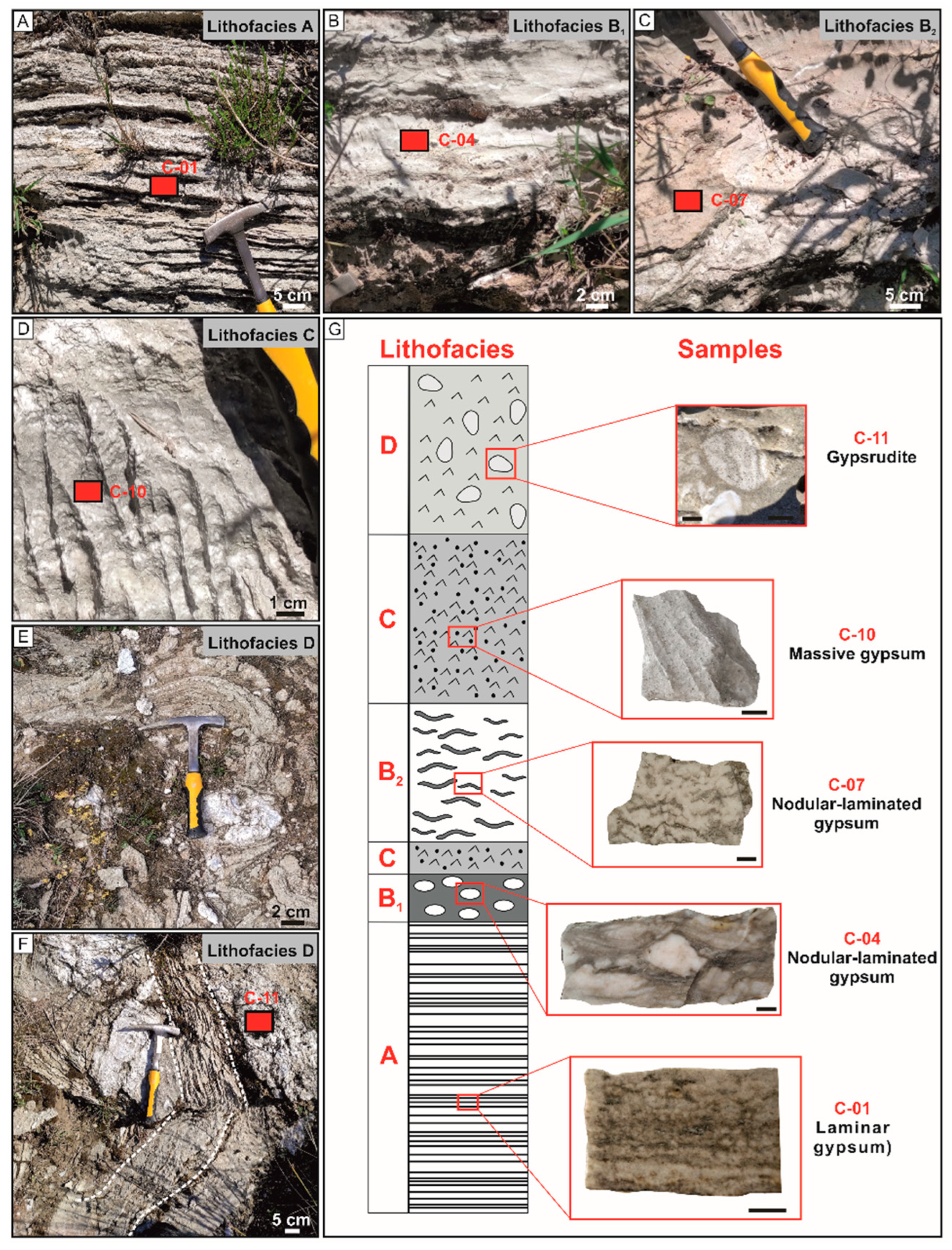
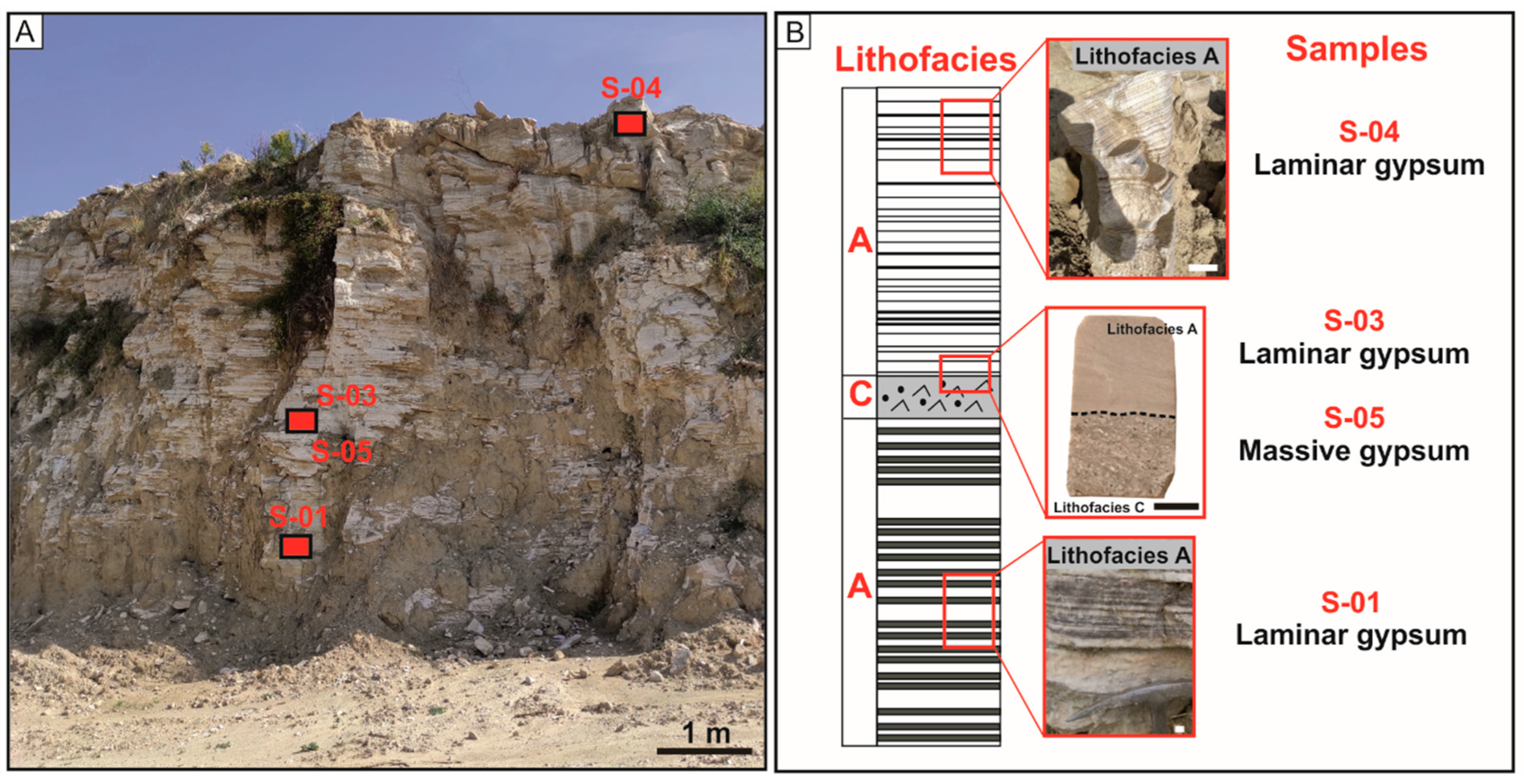
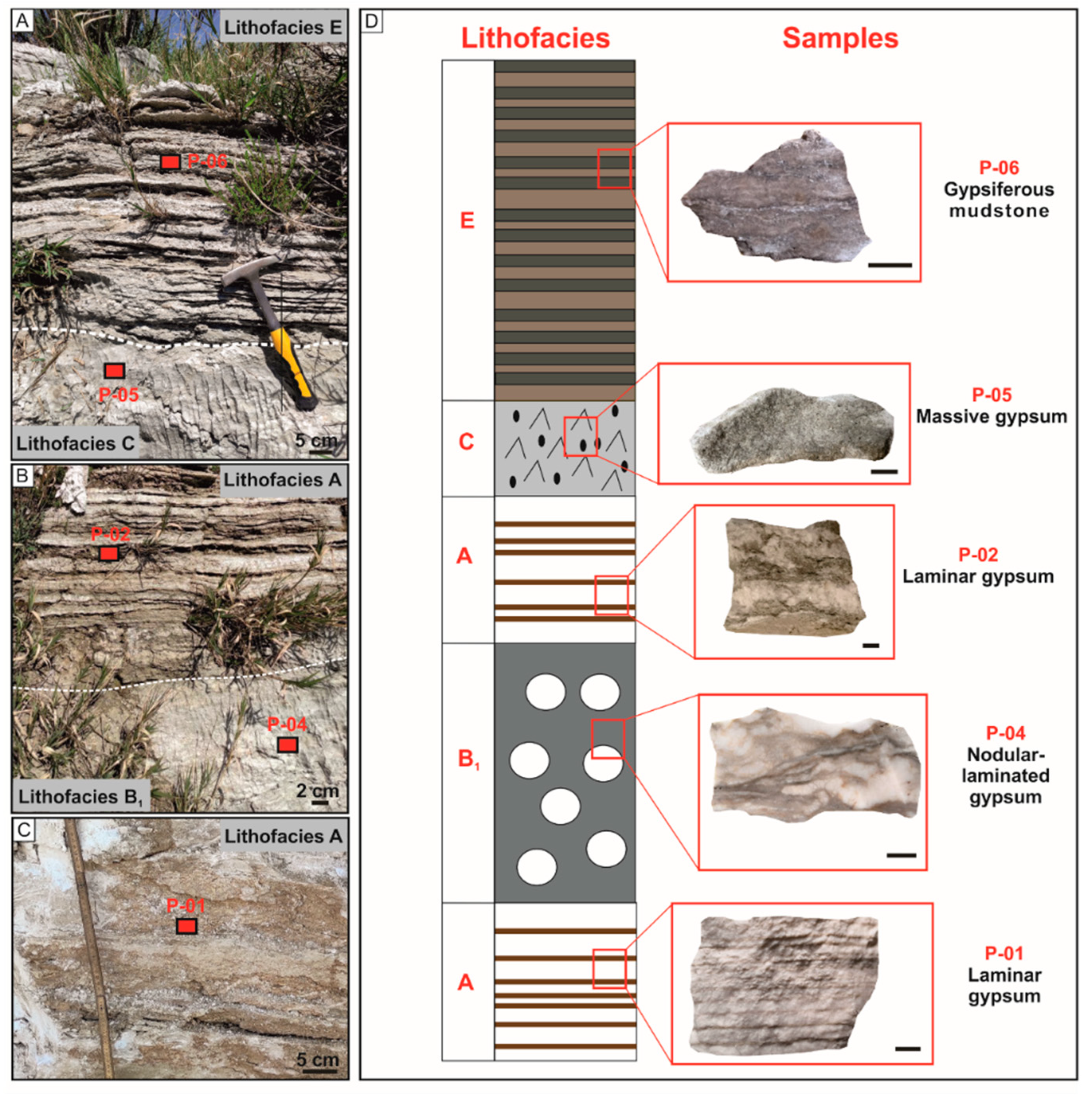

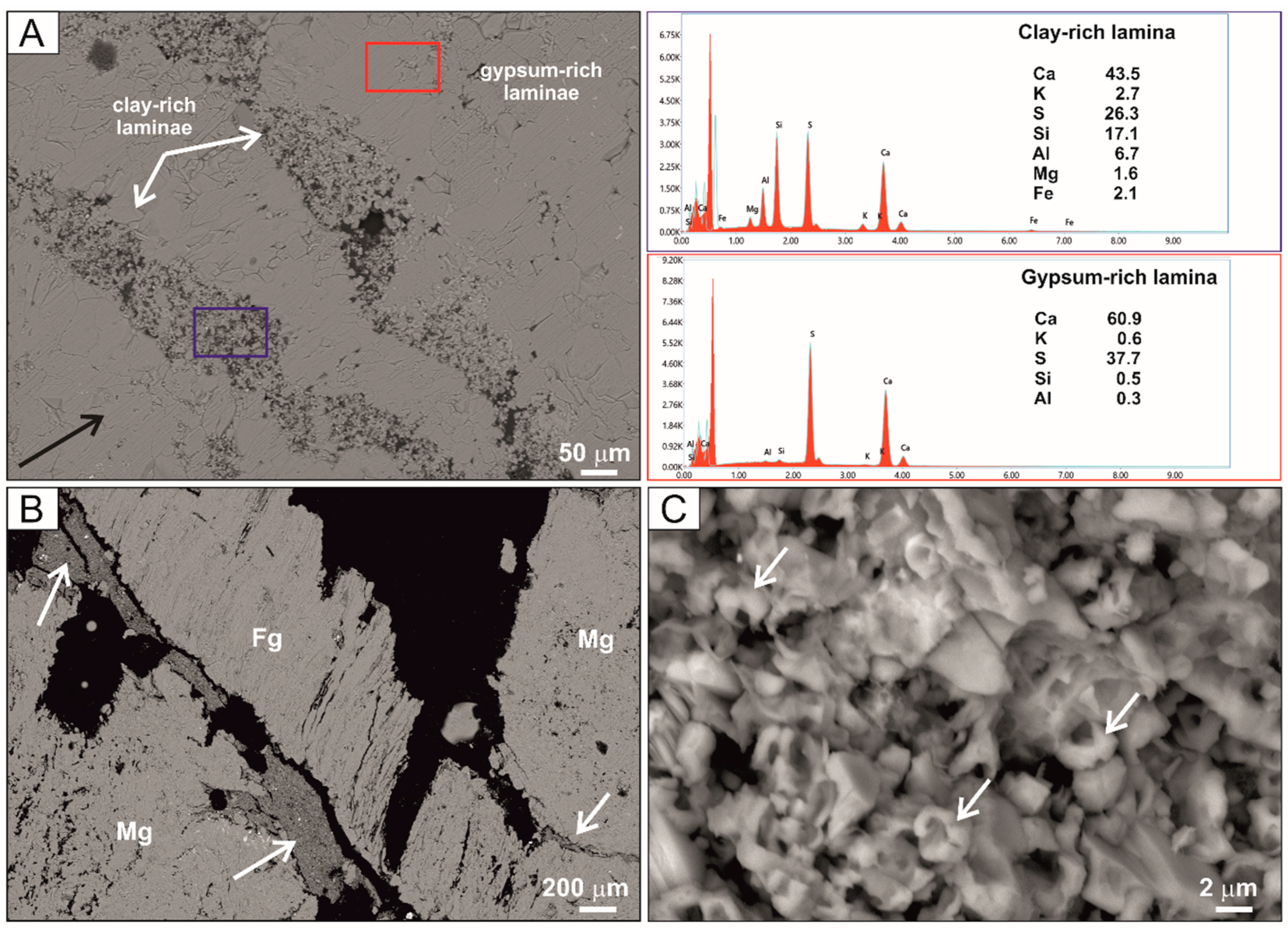
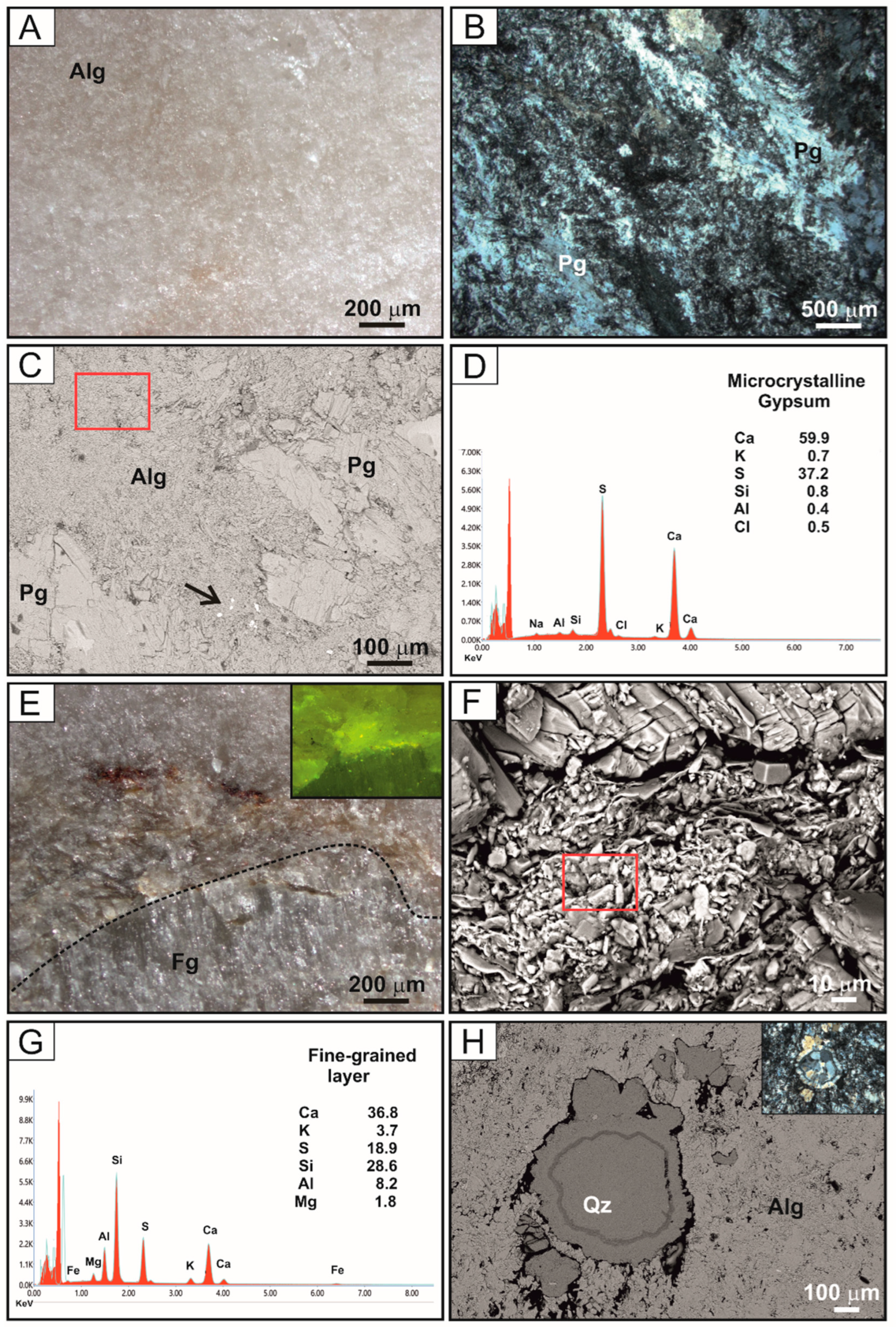

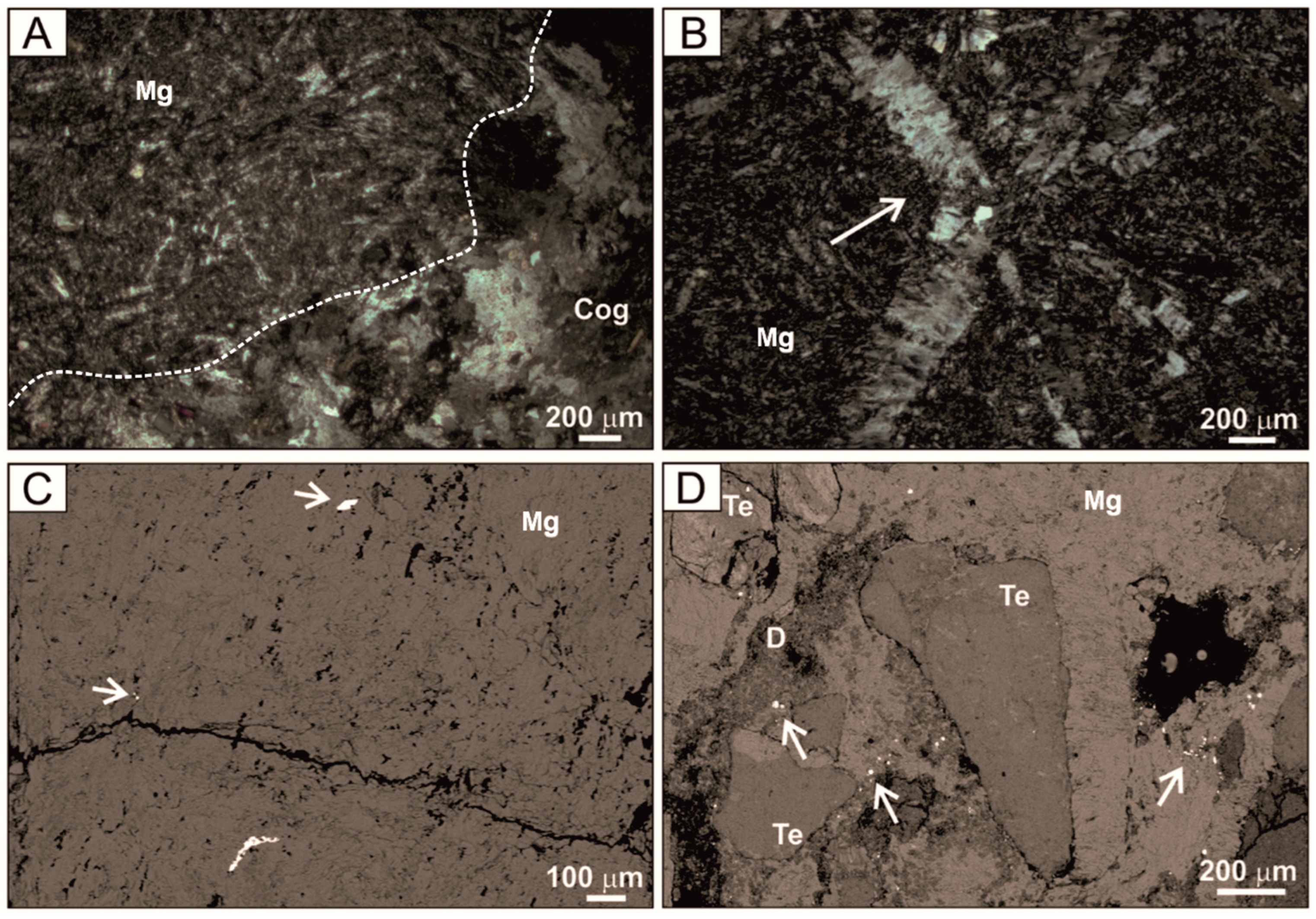

| Sampling Sections | Lithofacies | ||||
|---|---|---|---|---|---|
| Laminar Gypsum (Lith. A) | Nodular-Laminated Gypsum (Lith. B1 and B2) | Massive Gypsum (Lith. C) | Gypsrudite (Lith. D) | Gypsiferous (Lith. E) | |
| Castelluccio (1) | C-01, C-02, C-03 | C-04 to C-08 | C-09, C-10 | C-11, C-12 | n.p. |
| Striscioli (2) | S-01 to S-04 | n.p. | S-05 | n.p. | n.p. |
| Piretto (3) | P-01, P-02 | P-03, P-04 | P-05 | n.p. | P-06 |
| Lithofacies | Gypsum Textures | |
|---|---|---|
| Primary | Secondary | |
| Lithofacies A (laminar gypsum) | Microcrystalline | Acicular-like Coarsely crystalline anhedral Fibrous Alabastrine |
| Lithofacies B (Nodular-laminated gypsum) | n.p. | Fibrous Porphyroblastic Rosette gypsum |
| Lithofacies C (gypsarenite) | Microcrystalline (relicts) | Fibrous Alabastrine |
| Lithofacies D (gypsarudite) | Microcrystalline (relicts) | Coarsely crystalline anhedral Porphyroblastic Alabastrine Prismatic-radial gypsum |
| Lithofacies E (gypsiferous) | Microcrystalline | Alabastrine Porphyroblastic Fibrous |
Disclaimer/Publisher’s Note: The statements, opinions and data contained in all publications are solely those of the individual author(s) and contributor(s) and not of MDPI and/or the editor(s). MDPI and/or the editor(s) disclaim responsibility for any injury to people or property resulting from any ideas, methods, instructions or products referred to in the content. |
© 2025 by the authors. Licensee MDPI, Basel, Switzerland. This article is an open access article distributed under the terms and conditions of the Creative Commons Attribution (CC BY) license (https://creativecommons.org/licenses/by/4.0/).
Share and Cite
Dominici, R.; Costanzo, A.; Guido, A.; Maruca, G.; Perri, F.; Molinaro, D.; Cipriani, M. Short-Term Climate Oscillations During the Messinian Salinity Crisis: New Insights from Gypsum Lithofacies of the Crati Basin (Lattarico, Calabria, Southern Italy). Minerals 2025, 15, 542. https://doi.org/10.3390/min15050542
Dominici R, Costanzo A, Guido A, Maruca G, Perri F, Molinaro D, Cipriani M. Short-Term Climate Oscillations During the Messinian Salinity Crisis: New Insights from Gypsum Lithofacies of the Crati Basin (Lattarico, Calabria, Southern Italy). Minerals. 2025; 15(5):542. https://doi.org/10.3390/min15050542
Chicago/Turabian StyleDominici, Rocco, Alessandra Costanzo, Adriano Guido, Giuseppe Maruca, Francesco Perri, Davide Molinaro, and Mara Cipriani. 2025. "Short-Term Climate Oscillations During the Messinian Salinity Crisis: New Insights from Gypsum Lithofacies of the Crati Basin (Lattarico, Calabria, Southern Italy)" Minerals 15, no. 5: 542. https://doi.org/10.3390/min15050542
APA StyleDominici, R., Costanzo, A., Guido, A., Maruca, G., Perri, F., Molinaro, D., & Cipriani, M. (2025). Short-Term Climate Oscillations During the Messinian Salinity Crisis: New Insights from Gypsum Lithofacies of the Crati Basin (Lattarico, Calabria, Southern Italy). Minerals, 15(5), 542. https://doi.org/10.3390/min15050542










